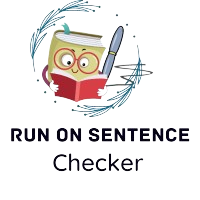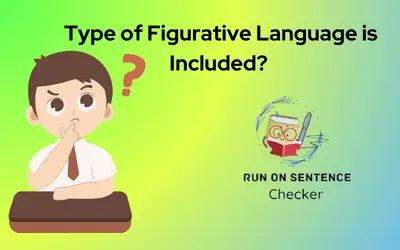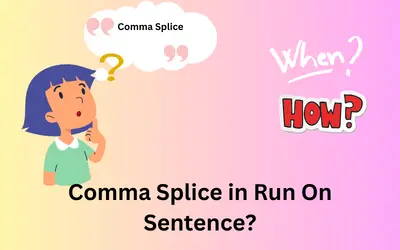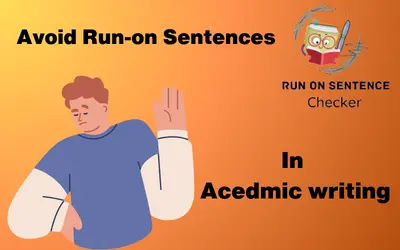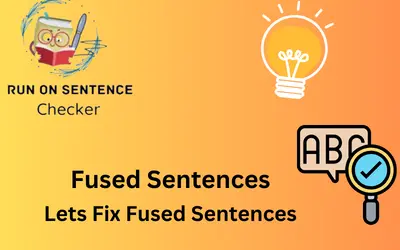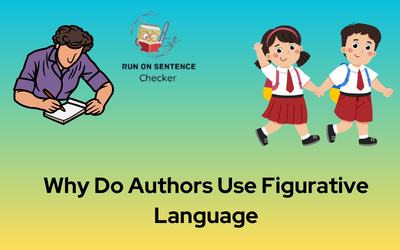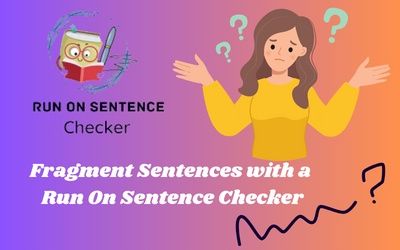Sentence correctness is crucial for effectively communicating ideas in the huge world of written communication. For writers who want to Check Run on Sentence is Correct or Not for improving their communication abilities, knowing how to determine if a sentence is right is essential, especially when it comes to run-on sentences.
Check Run on Sentence is Correct or Not Online Check
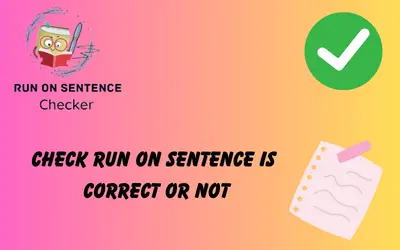
Recognizing run on sentences requires an understanding of sentence boundaries with our run on sentence checker tool. A sentence should be coherent and punctuated correctly at the conclusion. A run-on phrase frequently occurs when boundaries are ambiguous and concepts are incorrectly connected. Writers need to understand the boundary between one idea and the next.
It is essential to understand the common causes of run-on sentences in order to recognize them. Utilizing coordinating conjunctions (and, but, or, nor, for, so, still) incorrectly is one common offender. Run-on sentences can occur when certain conjunctions are used without the appropriate punctuation, such as a comma Splice or a semicolon.
Examples: Following are the example of the run on sentence corrector of your woods
Incorrect: She loves to write, she finds it therapeutic.
Correct: She loves to write. She finds it therapeutic.
Incorrect: I enjoy reading, I also love hiking.
Correct: I enjoy reading, and I also love hiking.
Incorrect: The sun was setting, it cast a beautiful glow across the horizon.
Correct: The sun was setting, casting a beautiful glow across the horizon.
Clarifying Grammar Rules for Run on Sentence
To effectively utilize a run-on sentence checker, it’s essential to have a solid understanding of the relevant grammar rules. Clarifying these rules can significantly enhance your ability to identify and rectify run-on sentences.
Comma Splices and Fused Sentences
One common error leading to run-on sentences is the misuse of commas. Understanding the difference between comma splices (joining independent clauses with a comma alone) and fused sentences (joining independent clauses without any punctuation) is crucial.
Proper Use of Coordinating Conjunctions
When using coordinating conjunctions (and, but, or, nor, for, so, yet), it’s important to pair them with the right punctuation. A comma should precede the conjunction when connecting two independent clauses
Semicolons and Periods
Semicolons can be employed to connect closely related independent clauses without a conjunction. Periods, on the other hand, signify the end of a complete thought. Knowing when to use each is crucial for constructing clear and concise sentences.
Steps to Recognize Semicolons, Periods, and Splice Errors in run on sentence structure
1. Identify Independent Clauses:
- Independent clauses: These are complete thoughts that can stand alone as sentences.
- Example: She enjoys writing. It helps her relax.
2. Recognize the Need for Separation:
- If you have two independent clauses that are closely related, consider using a semicolon or a coordinating conjunction (and, but, or, nor, for, so, yet).
3. Using Semicolons:
- Usage: Use a semicolon to connect two closely related independent clauses without a coordinating conjunction.
- Example: She loves to write; it relaxes her.
4. Using Periods:
- Usage: Periods signify the end of a complete thought. Use a period when you want to create two separate sentences.
- Example: Writing is therapeutic. It helps her relax.
5. Avoiding Comma Splices:
- Comma Splice: Occurs when two independent clauses are incorrectly joined by a comma without a coordinating conjunction.
- Example (Incorrect): She enjoys writing, it relaxes her.
- Correction: She enjoys writing; it relaxes her.
6. Understanding Coordinating Conjunctions:
- Usage: Coordinating conjunctions (and, but, or, nor, for, so, yet) can be used with a comma to join two independent clauses.
- Example: He reads a lot, but he rarely finds the time.
7. Checking for Fused Sentences:
- Fused Sentence: Occurs when two independent clauses are incorrectly joined without any punctuation.
- Example (Incorrect): She loves to write it relaxes her.
- Correction: She loves to write; it relaxes her.
Conclusion
In the journey of understanding and rectifying run-on sentences, the significance of proper punctuation, specifically the use of semicolons and periods, cannot be overstated. This exploration has underscored the importance of recognizing independent clauses, employing the right punctuation marks, and steering clear of common errors like comma splices.
How often should I use a run-on sentence checker?
It’s advisable to use a run-on sentence checker regularly, especially during the editing phase, to ensure consistent improvement in your writing.
Can a run-on sentence checker identify complex sentence structures?
Yes, many advanced run-on sentence checkers can identify and provide suggestions for improving complex sentence structures.
Are there free run-on sentence checker tools available?
Certainly! There are several free run-on sentence checker tools online, offering basic functionalities to enhance your writing
What other writing issues can these tools help detect?
Apart from run-on sentences, these tools can help detect issues like punctuation errors, grammatical mistakes, and overall sentence clarity.
How can I improve my sentence structure without solely relying on a checker?
While checkers are valuable, improving sentence structure also involves regular practice, seeking feedback, and learning from experienced writers.
